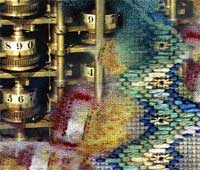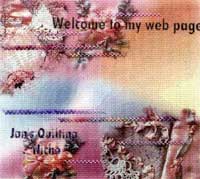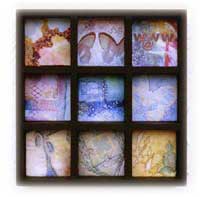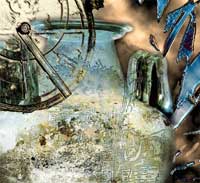Firstly let me introduce myself. My name is Sharon Boggon. I have signed my email correspondence sharon b for years now so, as my personal website grew it went by the title of sharon b. In July 2004 I registered inaminuteago.com and the site was renamed.
For those students that drop me an email because they have to write about a contemporary fiber artist. Firstly below is where you will find information about my work. If you really can't find an answer to a question feel free to email me but I won't write your essay for you. If the answer is on this or the about page I will simply redirect you back here and yes you can have an image or two for your essay. For those who want it this is where you will find my CV online.
About the artwork published online:
 This
site was originally produced in order to display some of my work but fast
became a major aspect of my work. I am an artist who is interested in the
connections between textiles and digital technology. I am interested not
so much in what the technology can do but how people are using the technology.
I see the internet as an extremely interesting cultural artifact.
This
site was originally produced in order to display some of my work but fast
became a major aspect of my work. I am an artist who is interested in the
connections between textiles and digital technology. I am interested not
so much in what the technology can do but how people are using the technology.
I see the internet as an extremely interesting cultural artifact.
Aware that when people encounter textiles they want to touch the work I attempt to provoke the desire to connect. In my work both online and off I aim to tap into a basic need to act in relationship to others. I use textiles and stitchery to seduce, draw people into the work, and act as a metaphor for the urge to connect with others in society. The desire to touch a textile, the need to connect with the work in a physical sense is also a metaphor for the internet and virtual communities.
Gallery:
A online gallery houses a number of my exhibitions. This section of the site houses The Shareware Project, Abbreviations, Craft is Dead Long Live Craft, Playing False and Samplers and Sampling. Please note that these projects were archived as they stood at the time of publication.
Some of the ideas and processes that drive my work:
Samplers and Sampling

One of the key issues in contemporary textile practice is one of appropriation and or derivation of works. With the invention and distribution of digital technology this has become a very complex area which I started to explore with Samplers and Sampling.
Digital sampling is when you take a section of a digital file and mix it, reshape and use it in another piece. Mostly people encounter this in music but artists have done it too. I was interested in how at the time (1996) the discussion around this practice was framed in such a way as to infer that this was a new practice whereas in textiles women had produced samplers by copying, changing and reshaping designs for hundreds of years in needlework samplers.
This exhibition was held in March 1997. In this section of the site there
is further information about the exhibition including technical information
on printing on fabric from computer. This exhibit has been archived as it
was published in 1996-7. There is also an article on samplers titled A
History of Embroidery Samplers.
Samplers and digital technology both manipulate information in a manner that
questions the value and priority of the 'original'. This question surrounding
the value system associated with the 'original' object has proved to be a fascinating
theme which weaves itself constantly through out all my work. This
project has been archived as it stood in 1997
Playing False:

Apart from the fact that women dominate textile practice, one of the reasons that textiles is marginal or has been constructed as marginal, is that textile works are seen as being derivative. The notion of the "original" produced by the "artistic genius" in modern art is a concept which has driven the value system applied to all arts and artistic practice. In Playing False I explored this idea.
Playing False was the first body of work in which I looked at how the internet was being used. For this project I took screen shots of women's homepages with their permission. I then digitally manipulated the image with Adobe Photoshop, printed the image on fabric and embroidered them. These stitcheries were mounted on small panels and exhibited in groups of 4. In employing stitching on the panels I hoped to point to women's history, textile practice and since the pieces were all originally "home pages" women's domestic role.
Associated with this body of work I produced a website which is still online. I was interested in was how women were representing themselves on the World Wide Web. On this website I published the panels I had created. Each image in this exhibition is associated with an individual's site. A link to this source is provided on the page. I asked each woman what the internet meant to them. Some women took the opportunity to comment on building a home page and what the experience had meant to them. Their answer is published and on the same page I pointed a link back to their site, the "original" home page. The whole project was about pointing back to the "original" yet creating another body of work equally "original". As a project I wanted to create a tension between the original – derivation – appropriation.
As with the previous exhibition I have supplied more information online. Also within this section of the site is a note from Jenny McFarlane the Curator of Playing False and a Catalogue essay written to accompany the show. This project has been archived as it stood in 1997.
Abbreviations
 Abbreviations was
held in May of 1998 at the ANCA Gallery in Canberra ACT Australia. With this
particular group of works I explored the idea of virtual travel and some
of the more subtle areas of our cultural heritage that are in play when we
use the internet. For this series of works I produced a series of textiles
which where presented within 5 separate shadow boxes.
Abbreviations was
held in May of 1998 at the ANCA Gallery in Canberra ACT Australia. With this
particular group of works I explored the idea of virtual travel and some
of the more subtle areas of our cultural heritage that are in play when we
use the internet. For this series of works I produced a series of textiles
which where presented within 5 separate shadow boxes.
Constant exposure to images of cultural icons can act to frame your experience of that place or object when you encounter it. I was interested in how when you visit a famous place or see a famous painting you bring your own history and ideas when interpreting the experience of seeing. Many aspects of the online environment are rich areas of cultural re-presentation. The obvious area for those that interested in art and its related fields of study are the sites that re-present national art collections, archaeological sites, and ethnographic collections on line, but more subtle areas of our cultural heritage are also in play. I was interested in how this form of publication would influence how we saw these collections. In other words I was exploring how the internet might influence how we would we view the original.
Shareware Project:
In the Shareware Project I further explored the issues of original and aspects of derivation but also included the notion of cultural exchange and how it is tied to narrative. I wanted to explore this in order to illustrate aspects of the textile community on the internet.
The idea for the project was in response to a previous exhibition - Playing False. During this exhibition a computer was set up in the gallery to enable people to visit my website, read women's comments about building a home page and tell of their experiences on the internet then visit their personal sites. Like all artists, I was interested in viewers reaction to the work. Playing false was held in September 1997 and for some who were not actively involved in net life it was the first time that they realised 'other people were out there'. It was this sense of 'other people out there' was one of the things I wanted to take further in the Shareware project. At the time I thought. Wouldn't it be good if the items I was working with were a real objects, something from a person's life?
I had built a site which houses a collection of embroidery stitches. This is an instructional site which gives step by step instructions on how to sew various hand embroidery stitches. It is the sort of information that would have been handed down from mother to daughter but today in our complex life, this type of skill is no longer passed on as a matter of course. Instead this information appears in print or in this case the site I have built online. The information on the site is free and given out to any visitor who may wish to print it. I requested that people who use my Stitch Collection pay me for it- a 'shareware payment' but I was not interested in money as such. I was interested in their story. I asked people to send me a piece of fabric, a button, lace or ribbon that had a story associated with it. With this the idea for the Shareware project was born.
I then scanned the objects and using Photoshop, and Illustrator worked a series of postcards. When I made the shareware project blogging software was not around and so a static site was the way to go. I built a site (still online) that published and illustrated the stories associated with the items, at the same time illustrating the process of creating a postcard from the materials sent to me. Each person had their own "postcard". These postcards they could print out if they chose to.
As a body of work the Shareware Project is in two sections. The first is the website which is still online. The second section further explores the tension between the original artifact and the simulated digital image. The first installment of Shareware project was exhibited in March 2000. I created a 10 metre panel made from hand-made envelopes made of rice paper, drafting film and glassine which held materials that I received in response to my request for 'payment'. I used these objects to provoke ideas of the slippery exchange between the virtual and the real. The second installment was made in a series of 8 panels which toured 6 of the 8 states and territories in Australia as part of the "Frisson" 14th Tamworth Fibre Textile Biennial exhibition.
The tensions established by the whole project were where is the original? Did this piece start with the stitch collection, with the item sent, with the scan of the item sent? Or did it start with the manipulation of the items sent? Is the original found with the story, or with the illustration of the story and image? Is the image created from the story and scanned item the original artifact? Was the original produced when the story was published on a site, or when the image was published on the site, or with the image of the postcard? Or was the original produced when assembled in a gallery? Is this appropriation? If so what was appropriated? Is it appropriation when something is freely given? Is this appropriation when the items are given as "payment"? Is this derivation? If so where along the line is it derivative? Is the item a gift? Is the stitch collection a gift? Is the project a gift? If so a gift too who? Who owns what part of the story? Who can give a story away? What is the object? Where is the cultural artifact? Is it online or off? Is it the website, the items scanned, the stories told? Which bit do I sign? In a digital age what and where is authenticity? Is authenticity found in the original request for honesty? In the form of payment for work online? Is the authentic to be found in the response by each member of the public telling his or her story? I could go on pointing to layers within layers and meanings within meanings but I think everyone gets the point.
Please note that this site has been archived as the exhibit was published in 2001.
Wisdom of the Ages:
 In "Wisdom of the Ages" I am asked the public to respond to the question: What lesson have you learnt in life? With this project I hope create a snap shot of common sense or popular wisdom.
In "Wisdom of the Ages" I am asked the public to respond to the question: What lesson have you learnt in life? With this project I hope create a snap shot of common sense or popular wisdom.
The idea is to simply to share some of the lessons in life and hopefully people will take pleasure in reading and responding to it.
Blogs
In January of 2004 I started a blog under the title In a Minute Ago... I started it as a place to keep track of the numerous sites I discovered while online and it has grown from there. As a blog it now covers contemporary and historical textiles, embroidery, quilting, and crazy quilting, fiber arts, paper arts, and book arts. It became Pintangle.com
I also now keep a second blog Tone and Tints which is my personal take on creativity, and using the process of journalling to capture ideas, and develop skills. Topics range over sketching, drawing, painting mixed media, and the associated equipment tools and techniques.
